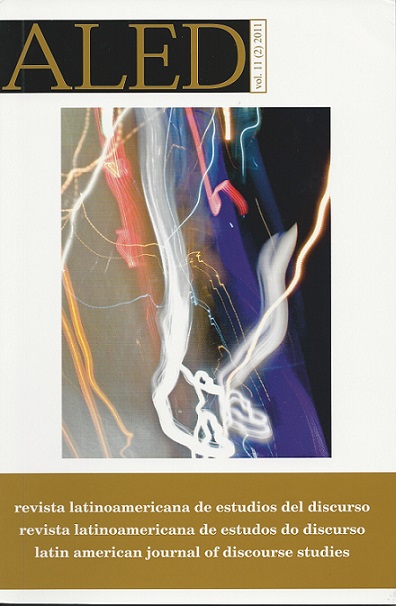La configuración discursiva de efectos incitativos en rumores económicos
Keywords:
rumor. device. incitement potential. effects. uncertainty.Abstract
This paper examines specific discursive properties that define the stockmarket rumor as a type of discourse that activates incitement, which is a constitutive mechanism of economic exchanges between market agents. Based on the renowned cliché within the international financial community, “buy on rumor and sell on the news”, this research explores relationships between “significant causality” (Boutaud and Veron, 2007) of rumor production, and the social construction of the bet in the stock-market. The main hypothesis of this work is that the incitement potencial (IP) of a market-rumor, instead of relying on random receptor psychological reactions, is conventionalized in the rules that make up the different discursive devices on the circulation of rumor-utterances. The evidence related to the presence or absence of IP in stock-market rumor-utterances are: the degree of deictic synchronization between production and recognition instances, and the social-contact modalities involved in the temporal phase of rumor-utterance circulation.
Downloads
References
ALEJO, R. (2010). ‘Where does the money go? An analysis of the container metaphor in economics: The market and the economy’, Journal of Pragmatics, 42: 1137-1150.
ANGENOT, M. (2010). El discurso social: los límites históricos de lo pensable y lo decible. Buenos Aires: Siglo XXI Editores.
BOUTAUD, J. J. & VERÓN, E. (2007). Sémiotique ouverte. Itinéraires sémiotiques en communication. Paris: Lavoisier, Hermes Science.
BOERS, F. & DEMECHELEER, M. (1997). ‘A few metaphorical models in (western) economic discourse’. In W.A. Liebert, G. Redeker, L. Waugh (eds.), Discourse and Perspective in Cognitive Linguistics, 115-129. Amsterdam and Philadelphia: John Benjamins.
DUCROT, O. (1987). El decir y lo dicho. Barcelona: Paidós.
DUCROT, O. (1988). ‘Argumentación y topoï argumentativos’, Lenguaje en Contexto, 1 (1-2): 63-84.
DUCROT, O. (1990). Polifonía y argumentación. Cali: Universidad de Cali.
FILINICH, M. I. (1999). Enunciación. Buenos Aires: Eudeba.
GARCÃA NEGRONI, M.M. (2000). ‘Acerca de los fenómenos de relectura y reinterpretación en el discurso’, Discurso y Sociedad, 2 (4): 89-108.
HEWINGS, A. (1990). ‘Aspects of the language of economics textbooks’, en T. DudleyEvans y W. Henderson (Eds.), The Language of Economics: The Analysis of Economics Discourse, 29-42. London/Basingtoke: Macmillan.
HYMES, D. (Ed.) (1964). Language in culture and society. New York: Harper and Row.
IRVINE, J.T. (1989). ‘When Talk isn‘t cheap: language and political economy’, American Ethnologist, 16 (2): 248-267.
KAPFERER, J. N. (1989). Rumores, el medio de difusión más antiguo del mundo. Barcelona: Plaza y Janes Editores.
KEYNES, J.M. (1936). The general theory of employment, interest and money. New York: Harcourt, Brace & World.
KIYMAZ, H. (2001). ‘The effect of stock market rumors on stock prices: Evidence from an emerging market’, Journal of Multinational Financial Management, 11: 105-115.
KOCKELMAN, P. (2006). ‘A Semiotic Ontology of the Commodity’, Journal of Linguistic Anthropology, 16 (1): 76-102.
KLAMER, A. (1990). ‘The textbook presentation of economics discourse’, en W.J. Samuels (Ed.), Economics as discourse: an analysis of the language of economists, pp. 129-154. Boston: Kluwer Academic.
LEVINSON, S. (1983). Pragmática. Barcelona: Teide.
MANDELBROT, B. & HUDSON, R. (2006). Fractales y finanzas. Una aproximación matemática a los mercados: arriesgar, perder y ganar. Barcelona: Paidós.
ORLEAN, A. (1999). ‘L’ individue, le marché et l’opinion : réflexions sur le capitalisme financier’, Esprit, Noviembre: 51-75. (Traducido al español por Inés Pousadela).
POUND, J. y ZECKHAUSER (1990). ‘Clearly heard in the street: the effect of takeover rumors on stock prices’, Journal of Business, 63 (3): 291-308.
REYES, G. (1994). Los procedimientos de cita: citas encubiertas y ecos. Madrid: Arco Libros.
ROSE, A.M. (1951). ‘Rumor in the stock market’, Public Opinion Quarterly, 15 (3): 461-468.
SCHINDLER, M. (2007). Rumors in the financial market, insights into behavioral finance. New York: Willey.
SEARLE, J., (1975). Actos de habla. Madrid: Cátedra.
TRAVERSA, O. (2001). ‘Aproximaciones a la noción de dispositivo’, Signo y Seña, Revista del Instituto de Lingüística de la UBA, (12): 233- 247
TRAVERSA, O. (2009). ‘Dispositivo-enunciación: en torno a sus modos de articularse’, Revista Figuraciones, (6): disponible en http://www.revistafiguraciones.com.ar/numeroactual/recorrido.php?idn=6&idr=48.
VERÓN, E. (1998). La semiosis social. Barcelona: Editorial Gedisa.
VERÓN, E. (2004). Fragmentos de un tejido. Barcelona: Editorial Gedisa.
ZIVNEY, T.L., Bertin, W. J., & Torabzadeh, K. M. (1996). ‘Overraction to takeover spéculation’, The Quarterly Review of Economics and Finance, 36 (1) : 89-115.
Downloads
Published
How to Cite
Issue
Section
License

This work is licensed under a Creative Commons Attribution-NonCommercial-NoDerivatives 4.0 International License.
The authors retain the copyright and guarantee RALED the right to be the first publication of the work as well as a Creative Commons Attribution License that allows others to share the work with recognition of authorship and the initial publication in this journal.




